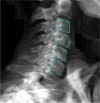Cervical spine and muscle adaptation after spaceflight and relationship to herniation risk: protocol from 'Cervical in Space' trial
- PMID: 35964076
- PMCID: PMC9375326
- DOI: 10.1186/s12891-022-05684-0
Cervical spine and muscle adaptation after spaceflight and relationship to herniation risk: protocol from 'Cervical in Space' trial
Abstract
Background: Astronauts have a higher risk of cervical intervertebral disc herniation. Several mechanisms have been attributed as causative factors for this increased risk. However, most of the previous studies have examined potential causal factors for lumbar intervertebral disc herniation only. Hence, we aim to conduct a study to identify the various changes in the cervical spine that lead to an increased risk of cervical disc herniation after spaceflight.
Methods: A cohort study with astronauts will be conducted. The data collection will involve four main components: a) Magnetic resonance imaging (MRI); b) cervical 3D kinematics; c) an Integrated Protocol consisting of maximal and submaximal voluntary contractions of the neck muscles, endurance testing of the neck muscles, neck muscle fatigue testing and questionnaires; and d) dual energy X-ray absorptiometry (DXA) examination. Measurements will be conducted at several time points before and after astronauts visit the International Space Station. The main outcomes of interest are adaptations in the cervical discs, muscles and bones.
Discussion: Astronauts are at higher risk of cervical disc herniation, but contributing factors remain unclear. The results of this study will inform future preventive measures for astronauts and will also contribute to the understanding of intervertebral disc herniation risk in the cervical spine for people on Earth. In addition, we anticipate deeper insight into the aetiology of neck pain with this research project.
Trial registration: German Clinical Trials Register, DRKS00026777. Registered on 08 October 2021.
Keywords: Astronaut; Atrophy; Disc prolapse; Microgravity; Prolapse; Vertebrae.
© 2022. The Author(s).
Conflict of interest statement
All authors declare they have no conflicts of interest.
Figures






Similar articles
-
Biomechanical changes in the lumbar spine following spaceflight and factors associated with postspaceflight disc herniation.Spine J. 2022 Feb;22(2):197-206. doi: 10.1016/j.spinee.2021.07.021. Epub 2021 Jul 31. Spine J. 2022. PMID: 34343665
-
From the international space station to the clinic: how prolonged unloading may disrupt lumbar spine stability.Spine J. 2018 Jan;18(1):7-14. doi: 10.1016/j.spinee.2017.08.261. Epub 2017 Sep 28. Spine J. 2018. PMID: 28962911 Free PMC article.
-
Neurosurgery and spinal adaptations in spaceflight: A literature review.Clin Neurol Neurosurg. 2021 Aug;207:106755. doi: 10.1016/j.clineuro.2021.106755. Epub 2021 Jun 8. Clin Neurol Neurosurg. 2021. PMID: 34126454 Review.
-
Preflight, In-Flight, and Postflight Imaging of the Cervical and Lumbar Spine in Astronauts.Aerosp Med Hum Perform. 2018 Jan 1;89(1):32-40. doi: 10.3357/AMHP.4878.2018. Aerosp Med Hum Perform. 2018. PMID: 29233242
-
Disc herniations in astronauts: What causes them, and what does it tell us about herniation on earth?Eur Spine J. 2016 Jan;25(1):144-154. doi: 10.1007/s00586-015-3917-y. Epub 2015 Apr 18. Eur Spine J. 2016. PMID: 25893331 Review.
References
Publication types
MeSH terms
Grants and funding
LinkOut - more resources
Full Text Sources
Medical

